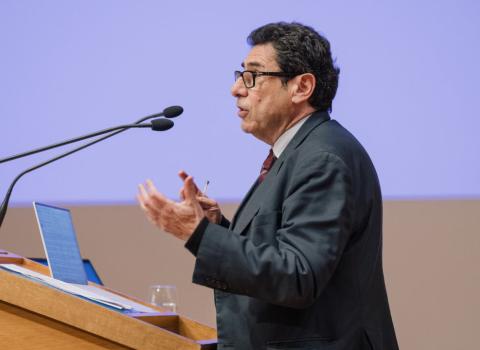- The organisation obtains seven Starting Grants from the European Research Council to study the evolution of animals, investigate eukaryotes and understand brain development
- Quantum physics, magnetic fields on exoplanets and the relationship between the cerebral cortex and basic behaviours will also be investigated.
- Each of the awarded projects will receive about 1.5 million euros over the next 5 years
The Spanish National Research Council (CSIC) has obtained seven Starting Grants, which are awarded annually by the European Research Council (ERC). This is the highest number reached by the institution in the same call. These projects, included within the Excellent Science pillar of the Horizon 2020 Research and Innovation Programme, represent approximately € 1.5 million of funding for each project over five years. Leading the projects are Rosa Fernández and Daniel Richter, both researchers from the Institute of Evolutionary Biology (IBE-CSIC-UPF); Juan Antonio Moreno-Bravo and Félix Leroy, from the Institute of Neurosciences (IN-CSIC-UMH); Can Onur Avci, from the Barcelona Institute of Materials Science (ICMAB-CSIC); Daniele Viganó, researcher at the Institute of Space Sciences (ICE-CSIC), and Mª José Martínez-Pérez, from the Institute of Nanoscience and Materials of Aragón (INMA-CSIC-UNIZAR).
The research directed by Rosa Fernández, from IBE-CSIC-UPF, in the SEA2LAND project aims to study the evolution of land animals and what the genomic milestones have been to move from a marine origin to a land life. “To conquer the terrestrial environment, animals radically changed the way they breathe, reproduce, move or smell. And they did it several times in Earth's history. Understanding this process is key to understanding animal biodiversity”, says the scientist. "We are going to study whether, as is believed, animals are equipped with a kit of genetic tools that allows them to adapt to ecosystems. To do this we will focus on several questions: which genes facilitated life on Earth, how aquatic and terrestrial animals differ, and how animals reconfigured their genomes to adapt to a dry environment”.
GROWCEAN, the other IBE-CSIC-UPF project, aims to “characterise the biology, the interactions between species and the ecology of the most abundant and unknown eukaryotic microbial organisms in the oceans, where half of global photosynthesis occurs”, explains Daniel Richter. “We have three goals: to establish robust laboratory cultures to understand their life history and behaviour, to sequence their transcriptomes at the single-cell level to produce gene catalogues and their potential functions, and to interpret our results to characterise their relevance to the global ecosystem.”, concludes the scientist.
Juan Antonio Moreno-Bravo, from IN-CSIC-UMH, is the principal investigator of CERCODE, a project that seeks to understand the mechanisms by which the cerebellum could influence the development and function of the cerebral cortex. "The cerebellum plays a critical role in motor function, but also in cognitive development and social behavior, functions mainly associated with the cerebral cortex", comments the researcher. “Early alterations of the cerebellum give rise to various neurodevelopmental pathologies, such as autism spectrum disorders. We believe that these cerebellar dysfunctions produce, remotely, cortical alterations. These, in turn, could be the cause of the cognitive deficits present in these disorders. These basic processes and mechanisms are unknown and defining them is key to understanding the involvement of the cerebellum in developmental disorders”, he points out.
The IN-CSIC-UMH is also going to develop the MOTIVATEDBEHAVIORS project. As Félix Leroy, the principal investigator, explains, “the objective is to study how our cognition –the cortex- can regulate the activity of the various hypothalamic nuclei that control basic behaviours such as sociability, aggression, mating or eating”. Furthermore, the cortex is implicated in various psychiatric disorders associated with altered social behaviours: schizophrenia, autism or bipolar disorder. To understand both basic neural mechanisms and disease processes, it is essential to understand how memories and decisions regulate low-level motivated behaviours. This information may suggest new approaches to treating abnormal social cognition associated with psychiatric disorders”.
Quantum Physics and Exoplanets
MAGNEPIC project, which will have Can Onur Avci as the main researcher and in which the ICMAB-CSIC participates, intends to unite the already established knowledge on magnetic isolators with current experience in spintronics and measurement techniques. As Avci explains, "this project will provide ground-breaking knowledge of magnetic isolators for spintronics and will demonstrate concepts of fast, efficient and innovative devices for manipulating magnetic data in order to improve the sustainability of computing technologies."
Studying the traces of magnetic fields on exoplanets, that is the goal of IMAGINE. "Our project focuses on magnetic fields as a key factor for the habitability of rocky planets, just like on Earth, and as a messenger of the internal composition and dynamics of exoplanets", explains scientist Daniele Viganò, from ICE-CSIC. “Combining a novel formulation, detectable radio wave emission studies, and partially imported advanced numerical techniques adapted from the magnetised neutron star scenario, IMAGINE will predict magnetic field values for different exoplanets, comparing the associated observable properties of gas giants and contributing to identify the best candidates for rocky worlds for their habitability”, concludes Viganò.
"The purpose of the QFAST project is to investigate quantum properties in stabilised topologically protected magnetic excitations in ferromagnetic microdisks at millikelvin temperatures," says QFAST principal scientist, Mª José Martínez-Pérez. The research, in which INMA-CSIC-UNIZAR participates, will start from quantum nanocircuits based on a high critical temperature superconductor. “These studies will open new opportunities for future research, for example to transduce between microwaves and optical photons. The results may be relevant for applications of quantum information and dark matter detection”, adds the researcher.





 A unique international forum for public research organisations and companies to connect their external engagement with strategic interests around their R&D system.
A unique international forum for public research organisations and companies to connect their external engagement with strategic interests around their R&D system.